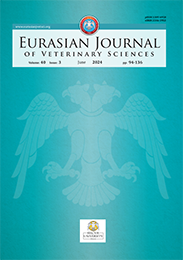| 2012, Cilt 28, Sayı 1, Sayfa(lar) 031-037 |
| [ Türkçe Özet ] [ PDF ] [ Benzer Makaleler ] |
| Epidemiology and pathology of intestinal helminthiasis in fowls |
| Dipti Rani Paul1, Anita Rani Dey2, Farhana Bilkis1, Nurjahan Begum1, Md. Motahar Hussain Mondal1 |
| 1Department of Parasitology, Faculty of Veterinary Science, Bangladesh Agricultural University, Mymensingh 2Department of Pathology and Parasitology, Faculty of Veterinary and Animal Science, Sylhet Agricultural University, Sylhet Bangladesh |
| Keywords: Epidemiology, pathology, fowl, Bangladesh |
| Downloaded:2697 - Viewed: 3282 |
|
Aim: To investigate the epidemiology and pathology of intestinal
helminthiasis of indigenous fowls.
Materials and Methods: 109 fowl's viscera were collected from local market. Identification of helminths was done according to age, season and sex. Results: Over all 79 (72.47%) fowls were infected with one or more species of helminths. Seven species of helminth including two trematodes (Catatropis verrucosa, Echinostoma revolutum), three cestodes (Raillietina tetragona, Raillietina echinobothrida, Raillietina cesticillus) and two nematodes (Ascaridia galli, Heterakis gallinarum) species were identified. Significantly (p<0.01) higher prevalence of helminths were recorded in adults (78.37%) and males (78.43%) than in young (60%) and females (67.24%), respectively. Fowls were 1.85 times more susceptible (p<0.01) to helminth infection in dry season (79.55%) than wet season (67.97%). Intestine became thickened and inflamed with presence of necrotic spots. Conclusion: Intestinal helminths are the serious threat to the indigenous fowl production in Bangladesh. |
| [ Türkçe Özet ] [ PDF ] [ Benzer Makaleler ] |





